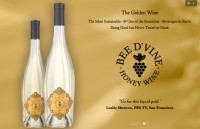Bee d’Vine honey wine teases palates while offering hope to Kaffa region beekeepers
It’s smooth and fragrant, with florals on the nose and a palate of almond, honeysuckle and jasmine. Its golden color and crisp finish hint at its distinctness amid the wine world, but the story behind Bee d’Vine t’ej is like any good wine — layered and complex.
 It all started in 2009, when Ayele Solomon visited the Kaffa rainforest in southwestern Ethiopia. Devastated by its deforestation, and noting the near-universal use of traditional beehives in the area, Ayele began dreaming of ways to begin a move toward modern-frame hives. As each modern hive yields 20-45 kilograms of honey each year, compared to a traditional hive’s 7, he reasoned that the conversion could increase household income for the region’s beekeepers fivefold while also helping to conserve the forest.
It all started in 2009, when Ayele Solomon visited the Kaffa rainforest in southwestern Ethiopia. Devastated by its deforestation, and noting the near-universal use of traditional beehives in the area, Ayele began dreaming of ways to begin a move toward modern-frame hives. As each modern hive yields 20-45 kilograms of honey each year, compared to a traditional hive’s 7, he reasoned that the conversion could increase household income for the region’s beekeepers fivefold while also helping to conserve the forest.
Reflecting on his Ethiopian heritage, Ayele started pursuing the creation of t’ej(Ethiopian honey wine) — the proceeds of which would fund hive conversion, creating a symbiotic cycle centering on honey. From there, the decisions of where and how to produce such wine evolved, with the rest of the story spanning five years and three countries.
After exploring possibilities in both Ethiopia and South Africa, Ayele ultimately set up the Honey Wine Company in San Francisco, California, for both personal and business reasons: He grew up there and has family in the area; high-quality honey is available locally; and California boasts a strong wine-industry infrastructure, as well as an extremely large market for commercial wines. The wine itself is produced in the nearby Napa Valley & Sonoma wine country.
“Our goal was to reintroduce mead as smooth honey wine that would not only appeal to people who already enjoy t’ej or regular mead,” says Ayele, “but also to people who appreciate grape wine.”
Using local premium orange-blossom honey and pure spring water, the company conducted years of winery trials before coming out with two versions of its t’ej: brut (dry) and demi-sec (mildly sweet). Both boast the floral qualities of honey while also possessing the balance and complexity of grape wine.
Indeed, “If someone handed you this excellently intriguing honey wine and told you it was made from an obscure Italian white grape varietal, you’d probably believe them,” writes Matt Kettman, a contributing editor for Wine Enthusiast magazine, of the brut.
“Unlike heady mead or cloyingly sweet concoctions made with honey, this straw-colored beverage … is just like a dry wine,” he adds, “offering the petrol characters of riesling, the brisk grassiness of sauvignon blanc, and the warmth of chardonnay.”
But as honey wine does not have the acidic tannins of grape wine, explains Ayele, “you won’t experience the typical grape wine aftertaste that some drinkers perceive as harsh or bitter.”
The first vintage of Bee d’Vine has won seven international medals in established wine competitions, including two golds. But The Honey Wine Company sees these honors as minor compared to the fact that “every sip of Bee d’Vine promotes a permanent change for thousands of beekeeping households and the forests of Kaffa.”
Indeed, once the Honey Wine Company repays its start-up debts, a percentage of wine sale profits will go toward beehive conversion in Kaffa. The company is also collaborating with California-based Wildlife Works Carbon to pursue large-scale conversions, with the hope of eventually sourcing specialty Kaffa honey for exclusive lines of Bee d’Vine — integrating yet another layer of delight to the honey wine’s story.
To learn more about Bee d’Vine, order wine or read Ayele’s book tracing the 8,000-year history of honey wine, The Celebrated Story of Honey Wine, visit beedvine.com.
Original article: Selamta Magazine



